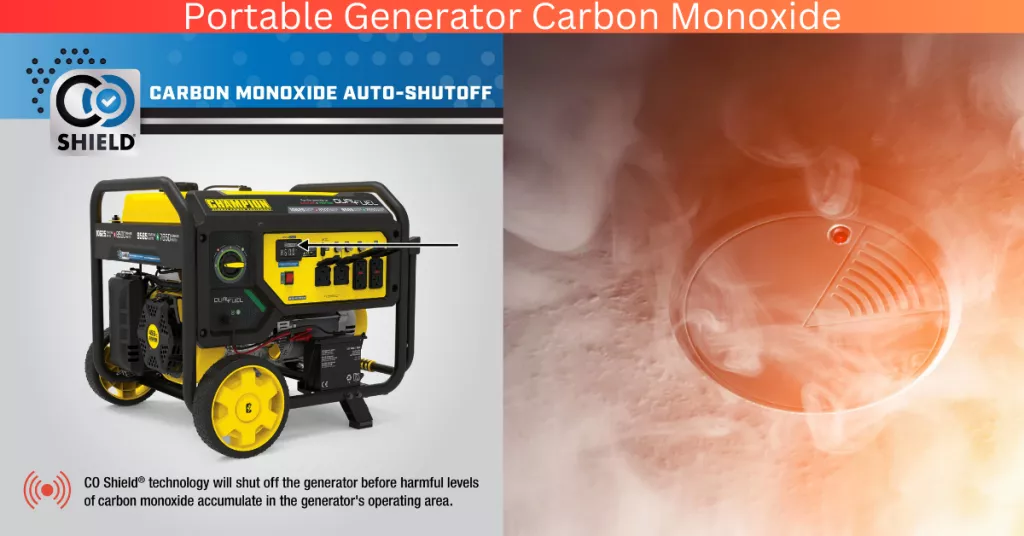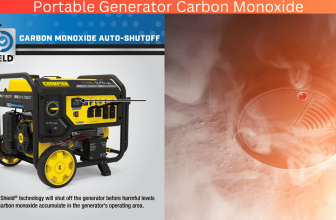I’ve always been a fan of camping and outdoor activities. There’s nothing quite like the feeling of being out in nature, surrounded by fresh air and beautiful scenery. But as much as I love the great outdoors, I know that safety should always come first. And when it comes to using a portable generator, safety is especially important.
Portable generators are incredibly useful, but they can also be dangerous if not used properly. One of the biggest risks of using a portable generator is the danger of carbon monoxide poisoning. Carbon monoxide is a colorless, odorless gas that can be deadly if inhaled in high enough concentrations.
That’s why it’s crucial to take the necessary precautions to prevent carbon monoxide dangers when using a portable generator. In this article, I’ll share some tips and best practices for staying safe while using a portable generator.
Key Takeaways
- Proper ventilation and placement of portable generators is key to ensuring safety.
- Portable generators should only be used outdoors.
- It is highly recommended to use a carbon monoxide detector when using a portable generator.
- Children and pets are especially vulnerable to the effects of carbon monoxide.

Understand the Dangers of Carbon Monoxide Poisoning
You need to understand the serious risks of carbon monoxide poisoning, so you don’t put yourself or your loved ones in danger while using a portable generator.
Carbon monoxide is a colorless, odorless gas that’s produced when fuel is burned. It can be lethal if inhaled in large quantities, as it blocks oxygen from being absorbed into the bloodstream and can cause symptoms such as headaches, nausea, dizziness, and even death.
It’s important to remember that carbon monoxide poisoning can happen quickly, especially in enclosed spaces. That’s why it’s crucial to always use your portable generator outside and away from open windows, doors, or vents that could allow the gas to enter your home.
Proper ventilation and placement of portable generators is key to ensuring your safety and the safety of those around you.
Proper Ventilation and Placement of Portable Generators
I want to talk about some important things to keep in mind when it comes to proper placement and ventilation of portable generators.
First and foremost, it’s crucial to remember that these generators should only be used outdoors.
Secondly, it’s important to keep them away from any windows or doors to prevent carbon monoxide from entering your home.
Lastly, I highly recommend using a carbon monoxide detector to ensure that you and your family stay safe while using a portable generator.
Outdoor Use Only
When using a portable generator, it’s important to remember that outdoor use only is the safest option to avoid carbon monoxide dangers. I know how tempting it can be to use a generator indoors during a power outage, but it can be extremely dangerous.
Carbon monoxide, a colorless and odorless gas, can build up quickly indoors and cause serious harm or even death. That’s why it’s crucial to use your generator outside, where there is proper ventilation and the risk of carbon monoxide poisoning is greatly reduced.
Additionally, using your generator outside will also prevent the risk of fire and other hazards associated with indoor use. It may seem inconvenient to have to go outside to turn on your generator or check on it, but it’s a small price to pay for safety.
Remember, the goal is to keep you and your family safe during a power outage, and using your generator outside is a crucial step in achieving that.
Speaking of safety, another important thing to keep in mind is keeping your generator away from windows and doors, which I’ll discuss in the next section.
Keep Generators Away from Windows and Doors
To ensure a pleasant and safe experience, it’s best to place generators a safe distance away from windows and doors. Here are five reasons why:
- Carbon monoxide can easily seep into your home through open windows and doors, causing harm to you and your loved ones.
- Generators need to be far enough from windows and doors so that exhaust fumes don’t enter your home.
By placing generators away from windows and doors, you reduce the risk of damage to your home in the event of a fire. It’s important to keep generators away from areas where they can be tampered with, which is why placing them away from windows and doors is a good idea. In addition, keeping generators away from windows and doors can prevent noise pollution from disturbing your neighbors.
By taking these precautions, you can enjoy the benefits of a portable generator without putting yourself or others in danger. Moving forward, it’s important to also consider using a carbon monoxide detector to further ensure your safety.
Use a Carbon Monoxide Detector
Make sure you’ve got a carbon monoxide detector installed in your home before using your generator. This device can alert you to any dangerous levels of gas that may be present, as carbon monoxide is a colorless and odorless gas that can be deadly if inhaled in large amounts.
Having a carbon monoxide detector is not only important for your safety, but it can also give you peace of mind when using your generator. You can rest assured that you’ll be alerted if there are any dangerous levels of gas, and you can take immediate action to prevent any harm.
It’s important to remember that regular maintenance and inspection of your portable generator is crucial in preventing any carbon monoxide dangers. With that said, if the detector sounds an alarm, evacuate the area immediately and call emergency services.
Maintenance and Inspection of Portable Generators
Regular maintenance and inspections of your portable generator can help ensure the safety of you and your loved ones. It’s important to keep your generator in good working condition by checking the oil level, fuel filter, air filter, and spark plugs regularly. You should also inspect the generator for any signs of wear and tear, such as frayed wires or loose connections. If you notice any issues, it’s best to have a professional repair them before using the generator again.
In addition to regular maintenance, it’s important to only use your generator in a well-ventilated area. Never use it indoors or in an enclosed space, as this can lead to carbon monoxide poisoning.
This brings us to the next topic of using extension cords safely.
Use of Extension Cords
You can easily avoid a potential disaster by using extension cords properly and ensuring they are appropriate for your portable generator. When using an extension cord, it is important to make sure it is rated for outdoor use and has a three-pronged plug. The cord should also be heavy-duty and able to handle the wattage of your generator. It is recommended to use a cord that is at least 12-gauge and no longer than 100 feet.
To help you choose the right extension cord for your portable generator, refer to the following table:
| Gauge | Max Wattage | Max Cord Length |
|---|---|---|
| 18 | 1250 | 25 ft. |
| 16 | 1875 | 50 ft. |
| 14 | 3000 | 100 ft. |
| 12 | 3750 | 100 ft. |
| 10 | 7500 | 100 ft. |
By following these guidelines and selecting the appropriate extension cord for your portable generator, you can help prevent carbon monoxide poisoning and other safety hazards. Now, let’s move on to the next section about safe fuel handling.
Safe Fuel Handling
When handling fuel for your generator, it’s important to remember that gasoline is highly flammable and can easily ignite if not handled carefully. Here are some tips to help you handle fuel safely:
- Always store gasoline in a cool, dry, and well-ventilated area away from any heat sources or open flames.
- Never refuel a hot generator. Allow it to cool down for at least 15 minutes before adding fuel.
- Use a funnel to pour gasoline into the tank to avoid spills and minimize the risk of fire.
- Make sure to wipe up any spills immediately with a cloth or absorbent material.
These precautions may seem like common sense, but they are crucial to preventing accidents and keeping you and your loved ones safe.
Now that we’ve covered safe fuel handling, let’s move on to the next step: turning off your generator before bedtime.
Turn Off Portable Generators Before Bedtime
Before hitting the hay, make sure to shut off your portable generator to avoid any potential hazards. While you may think that leaving it on throughout the night is convenient, it can actually be extremely dangerous. Carbon monoxide, a colorless and odorless gas, can build up quickly and cause serious harm to you and your family.
Not only is it important to turn off your generator before bedtime, but it’s also crucial to make sure it’s placed in a well-ventilated area. Keep it at least 20 feet away from any doors or windows to prevent exhaust fumes from entering your home.
By taking these safety precautions, you can ensure that your family stays safe and healthy.
Now, let’s move on to the next section about keeping children and pets away from portable generators.
Keep Children and Pets Away from Portable Generators
If there are young children or pets in the area, it’s important to keep them at a safe distance from your running generator. Carbon monoxide is an odorless gas that can be deadly, and it can quickly build up in enclosed spaces. Children and pets are especially vulnerable to the effects of carbon monoxide, so it’s crucial to take extra precautions to keep them safe.
To keep your children and pets safe around your portable generator, consider these tips:
- Keep the generator at least 20 feet away from your home and any windows or doors.
- Create a barrier around the generator to prevent curious children and pets from getting too close.
By following these simple steps, you can ensure that your children and pets are safe while you use your portable generator. Remember, taking these precautions can save lives.
In the next section, we’ll discuss how to purchase a generator with safety features to further protect your family.
Purchase a Generator with Safety Features
Consider investing in a generator with built-in safety features to ensure that your family remains protected from potential hazards. Generators with features such as automatic shutoff when carbon monoxide levels become too high or overload protection can give you peace of mind and greatly reduce the risk of accidents.
Additionally, look for generators that have been certified by recognized safety organizations such as Underwriters Laboratories (UL) or the Consumer Product Safety Commission (CPSC). But even with safety features, it’s important to follow the manufacturer’s instructions to avoid any potential dangers.
This includes proper placement of the generator, ensuring proper ventilation, and using the correct type and amount of fuel. By taking these precautions, you can enjoy the benefits of having a portable generator without compromising the safety of your loved ones.
Follow Manufacturer’s Instructions
To properly use a generator, it’s essential to carefully follow the manufacturer’s instructions. This will ensure correct placement, ventilation, and fuel usage. Here are a few things to keep in mind when using a generator:
- Don’t use a generator indoors or in an enclosed area, even if you have ventilation. Carbon monoxide can build up quickly and cause serious harm.
- Use the right type of fuel and don’t overfill the tank. Gasoline should never be stored in the same area as a generator or near any heat sources.
- Make sure the generator is properly grounded and never use it in wet conditions. This can lead to electric shock or electrocution.
By following these guidelines, you can avoid the dangers of carbon monoxide and other hazards associated with generator use. In the event of an emergency, it’s important to have an emergency preparedness plan in place.
Emergency Preparedness Plan
Having a well thought-out emergency preparedness plan can be essential in ensuring your family’s safety during a power outage or natural disaster.
When it comes to preventing portable generator carbon monoxide dangers, it’s important to have a plan for where to place the generator and how to properly ventilate the area.
In my own emergency preparedness plan, I’ve designated a specific spot outside for our generator to be placed. It’s important to place the generator at least 20 feet away from any windows, doors, or vents to reduce the risk of carbon monoxide entering the home.
In addition to the placement of the generator, it’s important to have a plan for proper ventilation. This can be achieved by opening windows and doors, or by using a fan to circulate fresh air into the area.
It’s also important to ensure that the generator is not placed in an enclosed space, such as a garage or shed.
By having a solid emergency preparedness plan in place, you can ensure that your family stays safe and healthy during a power outage or natural disaster.
Frequently Asked Questions
What are the different types of carbon monoxide detectors available in the market, and which one is recommended for use with portable generators?
I recommend using a battery-powered carbon monoxide detector with a digital display, as it provides real-time readings and can be easily moved around. Other options include plug-in and hardwired detectors, but they may not be as portable.
Can a portable generator be used in an enclosed space if proper ventilation measures are taken?
No, a portable generator should never be used in an enclosed space, even with proper ventilation measures. Carbon monoxide can accumulate quickly and cause serious harm or even death. Always use generators outdoors and away from open windows and doors.
How often should a portable generator be serviced or inspected to ensure its safe operation?
As the owner of a portable generator, I make sure to have it serviced or inspected at least once a year to ensure safe operation. Regular maintenance can prevent potential hazards and prolong the life of the generator.
Is it safe to connect multiple extension cords to a portable generator, and what precautions should be taken when doing so?
Yes, it’s safe to connect multiple extension cords to a portable generator, but it’s important to use the correct gauge and length for the intended load. Avoid overloading the generator and always follow the manufacturer’s instructions for safe operation.
What are the legal requirements for using portable generators in residential areas, and what are the potential consequences of violating these regulations?
I researched the legal requirements for using portable generators in residential areas. Violating these regulations can result in hefty fines or even legal action. It’s crucial to follow guidelines to ensure safety for oneself and others.
Conclusion
In conclusion, as someone who’s experienced the dangers of carbon monoxide poisoning firsthand, I can’t stress enough the importance of following safety guidelines when using portable generators.
Taking the time to understand the risks, properly ventilating and placing the generator, performing maintenance and inspections, using extension cords safely, handling fuel with care, keeping children and pets away, and purchasing a generator with safety features can all contribute to preventing accidents.
Remember, emergencies can happen at any time and it’s crucial to have an emergency preparedness plan in place.
By following these guidelines and being proactive in preventing carbon monoxide poisoning, we can all stay safe and enjoy the benefits of portable generators without putting ourselves and others at risk.
Stay safe, and always prioritize safety when using portable generators.





